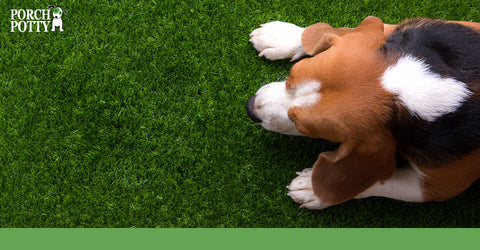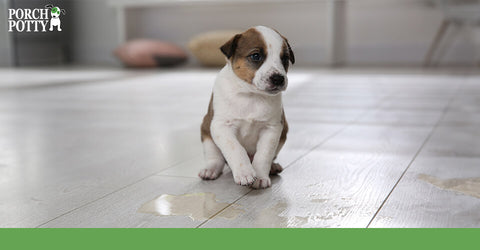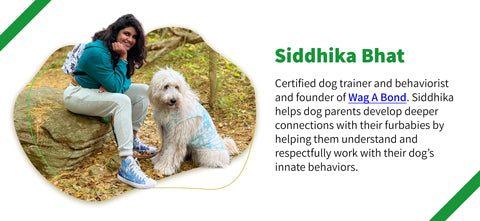
Puppies are adorable, and sweet, and stubborn. Toilet training takes patience and a sense of humour.
Toilet training a puppy requires consistency, kindness, and most importantly, a good sense of humour; sense of humour because if you keep fretting over the small stuff, you will definitely miss out on the bigger picture. It's a journey of love and learning for both the pet parent and the pup. Toilet training is often part of a larger routine, including feeding, walks, and play. Successful toilet training is detrimental to a dog's overall well-being. A well-behaved and house-trained dog is more likely to be included in various aspects of the pet parent’s life, thereby strengthening the bond through shared experiences.
How long can your puppy hold it?
Puppies are not born with the ability to control their bladder. They have to be trained to do so. Understanding your puppy’s bladder control ability is the first step towards building a routine for them as you will have to take into account how often they need to go.
There is a simple method to calculate the number of hours your puppy can hold it. The age of your dog in months + 1 = the number of hours your puppy can hold. So, if your puppy is 2 months old, your puppy can control their pee for a maximum of 3 hours.
However, this is a ballpark calculation and does not take into account the dog's size and several other factors. Smaller breeds like Chihuahuas and Dachshunds would feel the need to go a lot more frequently as compared to bigger breeds like Huskies and German Shepherds.
Common signs that your pup needs to go
Dogs are one of the most expressive and communicative species. This is what makes them endearing and suitable house pets. They find a way to communicate every need and want with us. All we have to do is observe closely. Here are some common signs indicating that your pup wants to pee:
- Excessive whining and barking for no apparent reason
- Circling in one place
- Sniffing excessively
- Sniffing and wandering off mid-play
- Sudden hyperactivity and nipping
- Restlessness
- Scratching at the door
These are some of the most obvious signs. Some pups may choose to be a little more subtle with their communication signs, which may be easy to miss out on. Supervise your dog closely, especially during the initial phase of toilet training to understand their body language thoroughly and not miss out on signs.
How to choose that perfect spot for your puppy
Finding the ideal spot for your pup to do their business is as important as training them to successfully use it. The perfect spot must:
- be easy for your dog to track and access from wherever they are in the house
- have their scent
- be in a quiet location to minimise distractions and chances of overstimulation
- be easy to clean if indoors
- have a surface that your pup loves and is comfortable using repeatedly
- be inviting and secure enough for your dog to do their business
Puppies can be trained to go indoors or outdoors on a long-term basis if they are trained from an early age. Your puppy will also develop their own preferences in terms of where they wish to relieve themselves depending on the pointers mentioned above. Take into consideration their preferences while finalising on a designated spot. Expect trial and errors initially.
Getting Ready!
If indoor toilet training is the way to go for you, make sure to have supplies beforehand to make the task easier on both yourself and your dog. Here are a few things you’d need if you plan on toilet training your dog indoors:
- puppy pads for temporary use
- an artificial turf like Porch Potty, preferably a self-cleaning one
- toilet-training attractant sprays
- enzyme cleaners
- stain removers
- odour neutralizers
- paper towels
- household items like vinegar, baking soda and dish soap
- treats to reward your dog
- a standard leash and collar to lead your dog successfully to their designated spot
Once you have your ammo in place, you’re ready to rock and roll!

Picking a spot for your pup to relieve itself is one of the most important parts of toilet training.
7 Steps to Toilet Training Success
Consistency, patience and constant supervision is a lethal combination when aiming for toilet training success. We have broken down the process of toilet training for first time puppy owners into 7 easy steps.
Step 1: Build a win-win routine
Dogs are creatures of habit. This means that they thrive on routine, predictability and consistency in their daily lives. Predictability in meal times, play time, rest and most importantly, pee and poo breaks is essential in helping dogs understand what to expect and reduces the likelihood of accidents due to stress and lack of clarity.
Apart from having set timings for meals, play, rest, potty, walks and sleep, try to keep a fixed rotation of activities. For example, the order of waking up, peeing, pooping, walking, eating and then resting in the crate in the morning must be anchored. Similarly, establish a similar rotation of activities for different parts of the day. This will help your dog catch on to routine in no time and result in accelerated housebreaking success.
Step 2: Watch like a hawk
If you say that you are closely monitoring your puppy day in and day out, yet find yourself cleaning accidents every now and then, are you really monitoring your pup? Close supervision involves not leaving your pup out of sight even for a second. This is your only chance to prevent accidents, understand their body language better and know when it is time for them to go. During the initial phase of potty training, monitor their water intake closely as that is an important indication of when they’ll want to go next.
Your dog may give you subtle or more clear signs like circling, crouching, whining, wandering off etc when they need to go. The moment you catch your dog exhibiting these signs, be quick to respond.
Step 3: Make it easy
When we say easy, we don’t mean Layman easy… We mean a 2-year-old-could-figure-it-out easy; because that’s about how smart your puppy is. If the Porch Potty is located in the balcony and your puppy is all the way in the kitchen, you have made it very difficult for your pup to use it when they need to go. They will most likely pick the easier option of having an accident on the way.
If the Porch Potty is in the balcony, your puppy’s entire existence must be in the only room that has the entry and exit to the balcony door. Make all their essential resources available in this space. It must be easy for your dog to track the Porch Potty every time they need to go and if your dog struggles even a little, be there to lead the way with a leash and some treats. Doing so consistently will help your dog figure it out sooner than you think.
Step 4: Lead your dog effectively and consistently
You can safely say that your dog is housebroken when he consistently walks up to his designated spot to do his business without any prompt or guidance from you. However, to reach that stage, several prompts and a ton of proactiveness is required from you in the initial stages of potty training. Avoid picking your puppy up and placing him on the spot because regardless of how many times you do it, your puppy will have no idea how he got there and he’ll continue to have accidents around the house.
Step 5: Focus on positive reinforcement
Living beings thrive on motivation. This is primarily the reason why positive reinforcement training has a high success rate. Don’t just reward big wins like your dog peeing on their designated spot. Reward smaller wins too such as hanging out near their potty spot, sniffing and exploring in that area, waiting near the door to be let out etc.
Step 6: Make use of the crate
Keeping an eye on your pup 24/7 can be exhausting and overwhelming. You will need a break at some point in time, but leaving your pup out of sight can still not be an option. This is when a crate comes in handy. Puppies generally don’t soil where they sleep and rest. After you’ve built a positive association with the crate, you can leave them in there for short periods of time during the day and get some rest. Make sure to put them in there only after they have relieved themselves, are well fed and well exercised. This will encourage them to settle down faster and sleep better in the crate.
Step 7: Ensure a good night’s rest for your pup
A good night’s rest is not only important for your pup’s overall physical and mental well being, but also a great stepping stone to potty training success. Establishing a consistent bedtime and wake-up routine helps in scheduling appropriate bathroom breaks. A well-rested puppy is more likely to have better bladder control, decreasing the likelihood of accidents in the house. Fatigue from lack of sleep can lead to increased stress and a decreased ability to hold urine.
Handling Accidents
How we handle accidents and pitfalls with our puppies not only determine the pace at which they learn, but also the kind of bond they will share with us in the near and far future. When you spot pee on your carpet, you have two options – 1. yell at your dog, get frustrated and punish them. 2. Quietly clean up the pee and monitor your pup better the next time. Option1 may come naturally to multiple pet parents, but it must be remembered that this option does nothing to teach the dog to do better next time. Option 2 may be harder to deploy, but ensures fool proof and long-term success. Some other ways to deal with puppy toilet accidents are:
- avoid engaging in aversive tactics like rubbing your pup’s nose in it. Once the accident has happened, your dog has already moved on. Any attempt to correct them after is futile
- up your supervision game
- consider shorter, but more frequent crate times during the day
- try to make the designated spot more easily accessible to your pup
- be quick to catch your dog in the act next time and immediately take them to their spot

Accidents are bound to happen during toilet training. Patience is a much-needed tool.
Troubleshooting
How do I get my puppy to sleep the entire night without waking up to pee?
Build your pup’s routine in a way that encourages them to sleep with an empty bladder, in a calm state of mind. Avoid physically intense activities at night as they may cause overstimulation and restlessness at night.
Limit your puppy’s water intake at night and consider cutting it off a couple of hours before bed time. Take your pup out just before they hit the bed so that they don’t feel the need to wake up in the middle of the night. Puppies can typically sleep at a stretch anywhere between 5-6 hours at night. Consider this time while pre determining their bedtime and wake up time.
Engage them in a calming activity or a soothing chew before bed time to help them calm down and sleep better.
My puppy is stubborn! He refuses to pee on the designated spot.
Your puppy could be refusing to pee on the designated spot that you have decided for them due to multiple reasons such as dislike towards the surface, too many foreign scents, too many distractions in the environment, a prefixed preference towards an alternate spot, etc. Try to get to the root cause of your dog’s “stubbornness” before trying to address it. Take into account your dog’s preferences while potty training them; you will see a major difference in results.
Your puppy’s health and its impact on potty training
A puppy's health can significantly affect their ability to succeed in toilet training. Sometimes, even if pet parents get everything right in terms of puppy raising and training, existing health issues may cause significant hindrances. Some underlying medical conditions that may adversely affect potty training are:
- Digestive issues such as diarrhoea may disrupt a puppy’s ability to control bladder movement
- Urinary tract infection may cause the puppy to pee in random spots
- Parasites may cause irritable bowel syndrome
- Stress may force a puppy to relieve themselves in the crate or other corners of the house
- Physical injuries or limitations may affect a puppy's mobility and ability to reach the designated toilet area
If you’re experiencing housebreaking issues in spite of consistently training your dog, check for underlying medical issues and rule them out with the help of your vet.
Pro tip from a professional dog trainer
As a trainer, the pressure to achieve toilet training success with my dog was naturally high. However, I tried not to rush the process for my pup as it is important for them and us to proceed at a pace they are comfortable with. Personally, the combination of providing my puppy with her familiar scent, preferred surface and ensuring ease of access to the designated spot proved to be a lethal combination. It helped me prevent accidents on time and enabled my puppy to proactively start using the spot consistently.
I made sure to reward small wins and celebrate big wins like there is no tomorrow. Lastly, consistency is key and is super underrated.
In Conclusion
Toilet training makes a great foundation for puppy raising and training. It requires effective communication between owner and puppy. When your puppy learns to rely on you for guidance on appropriate bathroom behaviour, it creates a groundwork of dependence and trust in your care.
Siddhika Bhat: Certified dog trainer and behaviourist and founder of Wag A Bond. Siddhika helps dog parents develop deeper connections with their furbabies by helping them understand and respectfully work with their dog's innate behaviors.
For more information on toilet training your dog, check out these articles:
Effective Dog Toilet Training Schedules for Any Weather
Top 5 Toilet Training Mistakes to Avoid: Expert Tips for Dog Owners
Accidents Happen: How to Manage and Prevent Toilet Training Mishaps




